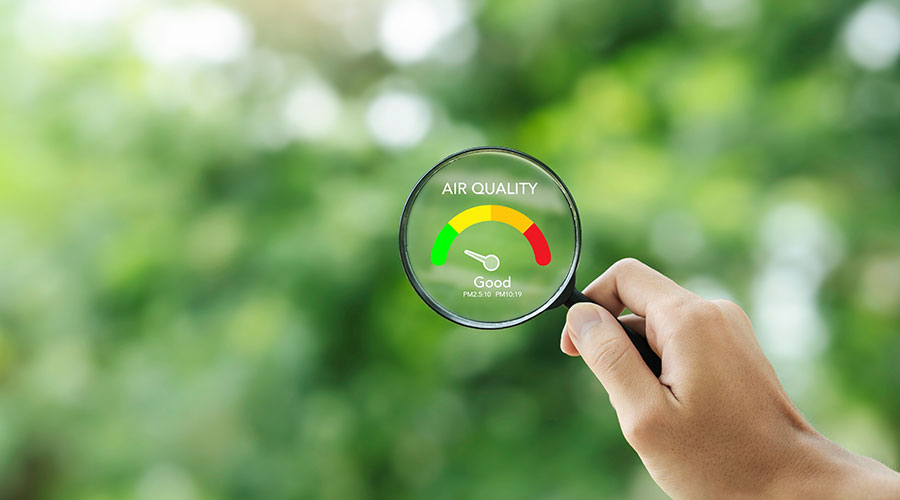IAQ: Focus on Filters
Expanding filtration technology options give managers opportunities to identify sources of indoor air quality problems and find the ‘right’ filter for the job
An air-filtration system installed as part of a building’s HVAC system is the first line of defense in maintaining acceptable indoor air quality (IAQ). As demands have grown for improved IAQ in institutional and commercial facilities, so have the capabilities of air-filtration systems.
Once designed primarily to protect HVAC system coils and ducts from dust and dirt, today’s filtration systems have evolved to address far more than particulate contaminants. Today’s designs can protect building occupants from gaseous, chemical, biological and radiological contaminants.
To use them effectively though, maintenance and engineering managers must match the capabilities of the different filtration systems to the needs of their facilities. New and revised standards are helping to streamline the process of matching needs with system capabilities.
New filtration technology has focused on three areas: improving the efficiency of particulate filters; improving filtration of gaseous contaminants; and enhancing removal of biological contaminants. All three areas offer technology that can significantly improve the IAQ in both new and existing facilities.
New-generation Particulate Filters
Particulate filters have long been the standard for air-filtration systems. Advances in filtration designs and materials used in filters have resulted in systems that produce cleaner air. Traditionally, as filter performance has increased, so has the pressure drop across the filter, producing higher energy requirements in order to move the required volume of air through the system.
The new generation of particulate filters offers improved performance without necessarily increasing fan energy requirements. For example, the latest particulate filters incorporate a range of media, including synthetic materials, and filters with more media configured with the same amount of filter area and with minimum efficiency reporting values (MERV) of 11-15.
Unlike many media used in the past, synthetic materials do not absorb moisture — a condition that creates a base on which bacteria can grow and eventually escape into the air stream. Synthetic materials also offer superior holding capability, so they resist releasing captured particulate material.
Most traditional particulate filters function by trapping particles between filter fibers, a process known as straining, or by impingement, which is trapping a particle that collides with a filter fiber. Some filters used a chemical binder to ensure that once they trap a particle, it remained attached to the filter media. Humidity, however, led to decreased performance in many applications.
A new-generation charged filter based on synthetic filter media helps eliminate this problem. A small charge, rather than a chemical binder, holds the particles. Humidity does not hamper their performance, and they can produce higher efficiencies with lower pressure drops. While questions remain as to the long-term performance of these charged filters, ASHRAE is revising Standard 52.2,1999, Method of Testing General Ventilation Air Cleaning Devices for Removal Efficiencies by Particle Size ,to include testing procedures for charged media filters.
Gaseous and Vaporous Contaminants
While filtering out particulate contaminants remains a major function of a building’s filtration system, filtration requirements now extend even further.
Maintaining proper IAQ also might require that the system remove gaseous and vaporous contaminants. The most common such contaminants in buildings include ozone, nitrogen oxide, nitrogen dioxide, carbon monoxide and sulfur dioxide. They enter buildings primarily through HVAC systems, typically as the result of placing outdoor-air intakes too close to sources of contamination, such as roadways, loading docks, parking garages, building exhausts, and Dumpsters. Since the typical gaseous contaminant is smaller than 0.01 microns, the traditional particulate filter cannot capture it.
In contrast, buildings and their contents generated most vaporous contaminants, and HVAC systems distribute them. Vaporous contaminants typically result from off-gassing from building materials, including carpet, carpet adhesives, insulation, furniture and various composite materials. Vaporous contaminants include both organic compounds and formaldehyde.
Gas-phase filters can remove both gaseous and vaporous contaminants. This generation of filter uses an adsorbent material — such as activated-carbon, chemisorbent media such as potassium permanganate, or chemically treated carbon media — to capture contaminants and remove them from the air stream.
Two basic types of gas-absorption filters are available:
- Physical adsorption units trap contaminants by attracting contaminant molecules to a surface, where weak electrical forces hold them.
- Chemisorption units trap contaminants by having them react with and form a chemical bond with a surface. In general, both require disposable or reusable canisters.
Removal efficiency depends on the unit’s design and the number of containers installed. Most well-designed units can remove vapors and gases as small as 0.0003 microns.
Before looking at specialized filter systems to remove gases and vapors, managers should try to eliminate contaminants at the source by:
- positioning air intakes well away from sources of gaseous contamination
- selecting interior materials that minimize or eliminate the generation of vaporous contaminants
- using localized exhaust systems to vent contaminants produced by activities or processes in a building.
Removing Biological Contaminants
Recent high-profile cases have focused IAQ attention on biological contaminants, in addition to particulate, gaseous, and vaporous contaminants. As with other efforts to improve IAQ, measures to reduce biological contaminants must start with good design and maintenance practices.
Even then, managers might be forced to consider other means to reduce levels of biological contamination. With the typical biological contaminant found in building HVAC systems falling between 0.1 and 10 microns in diameter, filtration is not effective. In fact, a dirty filter can provide an ideal environment for the growth of some biological contaminants.
A recent application of ultraviolet (UV) technology used in the 1950s in hospitals and tuberculosis wards has been to placed it airstreams to control microorganisms. Unlike filtration systems, UV-based systems do not actually filter contaminants from the air flow. Instead, they expose the air to UV light in the 200-280 nanometer range to kill a percentage of the biological contaminants, including many types of fungi, bacteria and viruses.
These systems are installed downstream from the main system filter in specially designed chambers. To be effective, UV filtration systems must fully expose the flow of air in the duct, and the flow must be slow enough to give the light sufficient dwell time to act on the microorganisms. A flow rate that is too high renders the system ineffective.
While the systems are effective on many biological contaminants — including viruses that cause influenza and the avian flu — they are not effective against biological contaminants of concern, such as anthrax. Research now under way will lead to systems specifically designed for those biological contaminants, but the best defenses today include monitoring, good maintenance practices, and high-efficiency media filters, those with a rating of MERV 13-15. Recently completed testing by the Research Triangle Institute — using three types of biological challenges, two bacteria and one virus — shows removal rates of up to 99 percent.
Standards to Help Managers
In looking for solutions to filtration-related IAQ problems, managers can turn to a number of standards.
ASHRAE Standard 52.2-1999 establishes minimum air filtration efficiencies. The standard deals with testing based on particle size, as opposed to earlier versions of the standard that focused on efficiency testing. It establishes a MERV for each filter.
Managers can use the standard to help select the most appropriate type of filter, based on the size and concentration of the contaminants in their particular application. The standard is being revised to include testing procedures for charged media.
ANSI/ASHRAE Standard 62.1-2004, Ventilation for Acceptable Indoor Air Quality, specifies minimum ventilation rates and IAQ requirements, including a rating of MERV 6 or better, for commercial and institutional buildings. ASHRAE has revised the standard to include recent data on the impact ventilation has on IAQ, including new ventilation rates and improved guidance on applying the standard. There also is a new standards committee, SPC 180, working to provide a maintenance standard of care for HVAC systems.
Matching Systems to Needs
Managers can use new-generation air-filters to improve IAQ in any facility, but not all technologies will benefit all facilities equally.
The first step is to make the best and most cost effective use of the technologies by considering a facility’s use, whether medical, educational, retail, office or retail. Each type of facility has its own requirements for air filtration.
The next step is to identify the source, type and level of contaminants found in the HVAC system supply, then identify and implement steps to reduce those levels before considering any filtration system.
The final step is to match the requirements to the capabilities of the various filtration systems available. Installing filters for non-existent contaminants simply increases costs. Installing filters that are not effective against known contaminants will not improve IAQ. But matching HVAC system capabilities to facility requirements will help managers efficiently and cost-effectively improve their facilities’ IAQ.
Spotlight: NAFA
The National Air Filtration Association (NAFA) is the national trade association for companies and individuals involved in the sales, service and manufacture of air filtration products. Among its resources and activities are these:
- Certification. The Certified Air Filtration Specialist (CAFS) certification is designed specifically for air-filtration professionals. The NAFA Certified Technician (NCT) program is designed for technicians involved in the installation, operation, and maintenance of air filtration systems.
- Publications. Among the publications NAFA offers are The Installation, Operation and Maintenance of Air Filtration Systems, NAFA Guide to Air Filtration, and NAFA User’s Guide for ANSI/ASHRAE Standard 52.2-1999.
- Product certification, through the NAFA Product Certification Program.
Click here for more information on NAFA and its activities and resources, or call (757) 313-7400.
|
James Piper, P.E., is a facilities management consultant with more than 25 years of experience in maintenance and engineering management issues
Related Topics:











